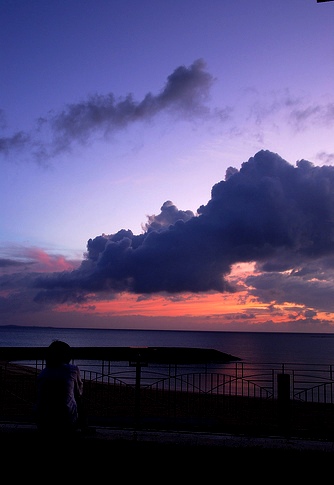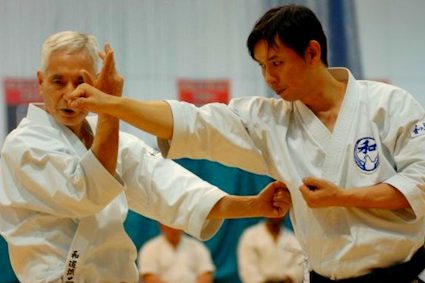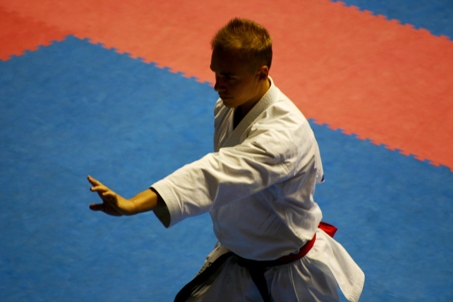It was a warm June evening in downtown Shuri. The sun was beginning to set, and I was getting a ride back to my apartment in an old Mercedes from my Kobudo sensei in Okinawa. Of course he didn’t need to, but he insisted.
We had been at some kind of party, of course.
Sometimes I wonder if they even do anything else in Okinawa – Karate, Kobudo and partying.
Anyway, back to the story. Sitting in the passenger seat, thinking about what I had seen and heard during the evening, I thought I would break the silence by asking my sensei a question. He seemed tired.
“Is our dojo famous in Okinawa?” I  asked.
asked.
And when I think about it now, it sounds like a strange question. But I’m a foreigner, so they are used to it.
My sensei turned to me and looked surprised.
“Well, yes, of course. Very famous. Why?” he asked.
I didn’t know what to say. I just mumbled something and looked out the window. I noticed some school children were on their way to practise. Probably yakyuu (baseball).
“Yes, why? Why had I asked that?” I thought. “Now he probably feels offended, like I think his dojo is inferior to other dojos. What a stupid question”.
There was silence.
I thought it would be best if I didn’t say anything more.
We came to a red-light. And by the way, there are way to many red-lights in Okinawan cities. And they last way to long.
More silence.
Getting uncomfortable…
He stared forward, I stared out the side window. An old lady was closing her yaoya (vegetable shop) for the day. She must have been at least 90.
My sensei suddenly broke the silence. It seemed like he wanted to explain something, like he felt my earlier question needed a deeper answer.
“Many Okinawan people don’t know real Kobudo. They can’t see” he said. “They don’t know the difference. What is real, what is copy? Everything looks the same. Karate people don’t know” he continued.
“Hai, hai…” I nodded understandingly. Somehow I had expected him to say something like that.
I felt a little bit sad for him.
And I understood exactly what he meant. Being one of the last true lineage holders of authentic Okinawan Kobudo, he had spent the last years really trying to spread the art, travelling all over Okinawa, teaching everywhere.
Still, like he said, most people can’t see the difference.
I remember earlier when I had heard about a well-known traditional Goju-ryu dojo where they had started doing Kobudo. How? Well, they did their normal Goju-ryu kata, except they put Kobudo weapons in their hands.
The kata Seienchin with sai was apparently getting popular.
I’m not making this up.
So I really knew what my sensei was talking about. He can immediately see if somebody’s Kobudo is authentic or not. But to someone who doesn’t know real Kobudo, everything looks good.
So it’s easy to make things up. Even in Okinawa.
And thats brings me to what I really want to discuss. One of the greatest myths that exist in Karate today:
The belief that the Okinawan and Japanese masters of Karate and Kobudo knows everything there is to know, and holds the keys to mastering the art.
Simply because they are from Okinawa or Japan, the birthplace of Karate/Kobudo.
The plain truth is that this is not the case.
However, we in the West love to hear the stories of the little, old, grey haired half deaf, half blind masters who have magical powers and hold secrets nobody will ever know (except their most loyal disciples) and so on. Secrets that a Westerner will never get their materialistic, money-hungry hands on.
In other words, Western practitioners often tend to place their Japanese/Okinawan teachers on pedestals that they would never even consider for an American, or European, teacher.
Why is that?
Because the Japanese sensei is better? Because the Japanese teacher has a higher grade? Because he has better credentials?
Or because the Japanese sensei simply is Japanese?
Let’s start saving for that plastic surgery folks…
The other side of the coin of this myth is that:
If you’re not getting your Karate/Kobudo from a Japanese/Okinawan sensei, then you’re simply not getting the real deal.
Nope.
I can’t agree with that either.
It is my belief that no nationality or “race” has a monopoly on doing, teaching or even understanding Karate and Kobudo, even though masters like Masatoshi Nakayama wants us to think that (by writing things like “Karate-do is a purely Oriental martial art” in the introduction to his book ‘Best Karate Comprehensive’). Not Japanese, not Okinawan, not American. Karate and Kobudo transcends national boundaries.
Some people just have a head start.
That’s all.
The Okinawans definitely have one, since it’s such an accepted part of their culture.
I mean, no one is saying that there are no great Japanese/Okinawan teachers. In fact, there are plenty (why shouldn’t there be?). However, we should recognize that there exists superb Western teachers too, who have discovered many things that Japanese/Okinawan masters have not.
Some of them will never.
Mainly because they aren’t allowed – partly because of their heritage and position, but also because of the square Japanese society and restrained culture that they live in. But, to be honest, their inflexible mindset is slowly changing as the new generation of Karate and Kobudo masters is formed…
I’ve met some of them, so I know.
There is a great quote on this topic, by the American anthropologist and scholar Joseph Campbell (1904-1987):
“An oriental expert of an oriental tradition will, by virtue of his race/nationality, always command more respect in his field than his occidental counterpart.”
And this is the exact reason Western teachers think they need to have a ton of photos of themselves with Japanese/Okinawan masters on their homepages.
It makes it more “real”, somehow.
This is the reason Western teachers always feel they need to prove themselves “worthy” of being a Karate/Kobudo sensei by name-dropping Japanese/Okinawan teachers on their homepages (me included, though I try to avoid it).
This is the reason Western teachers buy “authentic” ranks and Japanese-style diplomas with fancy signs on them and hang them proudly on their dojo walls. It’s basically the reason we do all of the stuff in Karate that we don’t understand but still do.
It’s quite sad, but that’s the way it is.
And will be.
Until people gradually learn to see.
To see the difference between what’s real and what’s not.
I will leave you with a quote by late Karate master Nagamine Shoshin (1907-1997) who once said the following:
“Foreign karate enthusiasts are too gullible, and blindly accept whatever their teachers tell them to be gospel. We have as many fakes, phonies, and frauds right here in Okinawa as you ever thought of having in America or elsewhere.”
The world is round.
Don’t be trapped in a square.



14 Comments